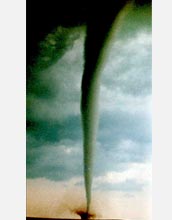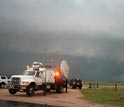|

Press Release 09-061
Largest Attempt in History to Understand Tornadoes Slated to Begin

Nationwide tornado experiment underway in May
April 7, 2009
An ambitious project to explore the origin, structure and evolution of tornadoes will take place from May 10-June 13, 2009, across the central United States. The project, VORTEX2 (V2), is the largest attempt in history to study tornadoes, and will involve more than 50 scientists and 40 research vehicles, including 10 mobile radars. Verification Of Rotation in Tornadoes EXperiment 2 (VORTEX2) is funded by the National Science Foundation (NSF) and the National Oceanic and Atmospheric Administration (NOAA), and involves scientists from NOAA, 10 universities and three non-profit organizations. Researchers will sample the super-cell thunderstorms that often form over more than 900 miles of the central Great Plains. Areas of focus include southern South Dakota, western Iowa, eastern Colorado, Nebraska, Kansas, the Texas panhandle and western Oklahoma. "An important finding from the original VORTEX experiment was that tornadoes happen on smaller time and space scales than scientists had thought," said Stephan Nelson, NSF program director for physical and dynamic meteorology. "New advances from VORTEX2 will allow for a more detailed sampling of a storm's wind, temperature and moisture environment, and lead to a better understanding of why tornadoes form--and how they can be more accurately predicted." NSF has contributed $9.1 million to VORTEX2. The original VORTEX program, operated in the central Great Plains during 1994 and 1995, documented the entire life cycle of a tornado for the first time in history. Recent improvements in severe weather warning statistics may be partly due to the application of VORTEX findings. V2 will build on the progress made during VORTEX and further improve tornado warning skills and short-term severe weather forecasts. Data collected from VORTEX2 will help researchers understand how the large-scale environment of thunderstorms is related to tornado formation, according to Louis Wicker, meteorologist at NOAA's National Severe Storms Laboratory and a V2 co-principal investigator. Participating scientists and students are from organizations throughout the United States and three countries, including the Center for Severe Weather Research, Rasmussen Systems, NOAA National Severe Storms Laboratory, OU/NOAA Cooperative Institute for Mesoscale Meteorological Studies, NSF-sponsored National Centers for Atmospheric Research, Penn State University, University of Oklahoma, Texas Tech University, Lyndon State College, University of Colorado, Purdue University, North Carolina State University, University of Illinois, University of Massachusetts, University of Nebraska, and Environment Canada and the Australian Bureau of Meteorology.
-NSF-

Media Contacts
Cheryl Dybas, NSF (703) 292-7734 cdybas@nsf.gov
Keli Tarp, NOAA (405) 325-6933 keli.tarp@noaa.gov
Related Websites
Vortex 2 Project: http://www.vortex2.org

The National Science Foundation (NSF) is an independent federal agency that supports fundamental research and education across all fields of science and engineering. In fiscal year (FY) 2009, its budget is $9.5 billion, which includes $3.0 billion provided through the American Recovery and Reinvestment Act. NSF funds reach all 50 states through grants to over 1,900 universities and institutions. Each year, NSF receives about 44,400 competitive requests for funding, and makes over 11,500 new funding awards. NSF also awards over $400 million in professional and service contracts yearly.
 Get News Updates by Email Get News Updates by Email
Useful NSF Web Sites:
NSF Home Page: http://www.nsf.gov
NSF News: http://www.nsf.gov/news/
For the News Media: http://www.nsf.gov/news/newsroom.jsp
Science and Engineering Statistics: http://www.nsf.gov/statistics/
Awards Searches: http://www.nsf.gov/awardsearch/
| 



